2-3 Match-Up Zone Defence: Featuring Trapping Post from Weak Side Guard
Most coaches would have seen a standard 2-3 Zone Defence, but there are opportunities to add in some elements that change this standard defence, to a 2-3 Match-up Zone Defence. With a few variations to the standard zone defence rotations, the normal weaknesses of the 2-3 Zone Defence can be nullified and force opposition offenses to adapt in game to meet the new defensive demands.
The 2-3 Match-up Zone Defence rotations are especially effective against motion offense principles against a zone defence. This is because the low post defensive player will close out in the dribbling lave normally taken by the offensive wing player to either Gap or Freeze Dribble.
Additionally, we will also explore the prospect of trapping in the postposition from the guard on the weak side of the floor.
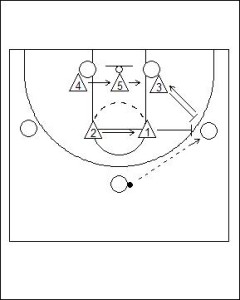
The offensive formation utilised in the diagram is a 3 Out and 2 In as this is one of the more commonly used sets against a 2-3 Zone Defence.
The 2-3 Match-up Zone Defence starts in the regular formation, but on a pass to the wing, the bottom defensive player (Three) closes-out to the ball handler on the wing. Simultaneously the closest guard (One) moves across to cover the wing offensive player. This movement means the offensive player should be guarded at all times.
The close-out by Three (3) should be up the passing lane between the perimeter player and the low post player. This will make the post entry pass harder to execute.
Timing is important with this rotation. Three (3) looks to lift and close-out on the offensive player finishing in a stance as the player receives the ball. Three (3) continues to hold this defensive position until the guard (One) has reached the offensive player. Only then, will Three (3) rotate back to the low postposition.
Two (2) moves across to guard the strong side high post.
Five (5) looks to cover the strong side low post offensive player while Three (3) is in the match-up rotation.
Four (4) rotates to cover the split line position.
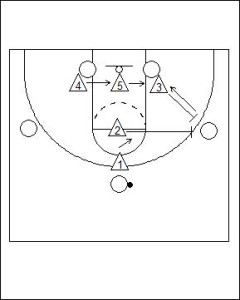
If there is an issue with the initial guarding of the ball handler, then an “i” formation between the guards can be utilised to help with the solving the rotational issues.
The rotation for all players works the same as highlighted in Diagram 1, however the second guard (Two) always takes the pass to either side of the floor with the top guard (One) rotating in behind to defend the high post.
If the opposition is continually trying to Gap Dribble the two guards then the i-formation will also solve this issue.
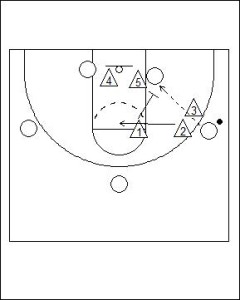
If a pass is made into the low post position while the rotation is happening between Three(3) and Two (2) an alternative movement is triggered.
Because many teams look to double from the player making the post entry pass, offenses tend to practice for this movement and have a good perimeter shooter in the three-point passing position. For this reason a different rotation can be used which sees the trapping player come from the weak side guard position to double the low post.
For this rotation, One (1) doubles the low post. One (1) must ensure to position themselves with their back towards the middle of the foul line as this will ensure a pass by the post players has to be made over the head of One (1) to the other offensive players on the floor. If One’s (1) hand pressure is good this will be a challenging pass to make for the post player who is being guarded by two players.
Instead of staying to guard the wing offensive player Two (2) rotates to the middle of the floor. Two (2) will be responsible for guarding the first pass made out of the post to the Point Position or the weak side foul line extended. When rotating Two (2) should be looking to split the difference between these two positions ready to attempt a deflection or finish in a defensive stance guarding the receiver once the ball is passed.
Three (3) stays guarding the strong side wing player who made the pass into the post. Three’s (3) only concern is denying this pass and isolating the post player from passing options one pass away.
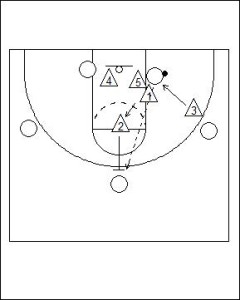
If the pass is made out of the post, Two (2) will rotate to guard the receiver of the pass. Again, if the on-ball pressure is good there should be a very good opportunity for a deflection or steal by Two (2). At the very least Two (2) should be able to reach the receiver as the catch is made.
One (1) replaces Two’s (2) position ready to close-out to the next pass on the perimeter.
Three (3) rotates back to the bottom of the 2-3 Match-up Zone Defence.
It is very important that when the ball is back at the Point Position that the 2-3 Match-up Zone Defence formation is regained. This will ensure the rotations are possible on the other side of the floor.
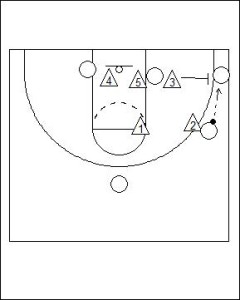
If the pass is made to the strong side long corner the rotation for the 2-3 Match-up Zone Defence is the same as the standard zone defence with Three (3) rotating to guard the player and all the bottom players shifting across one position in the zone.
There will be an opportunity here to either have Two (2) rotate in behind Three (3) to help in a dribble drive situation or deny the reversal pass back to the wing position. The rotation should depend on what is most challenging for the offense to face.







